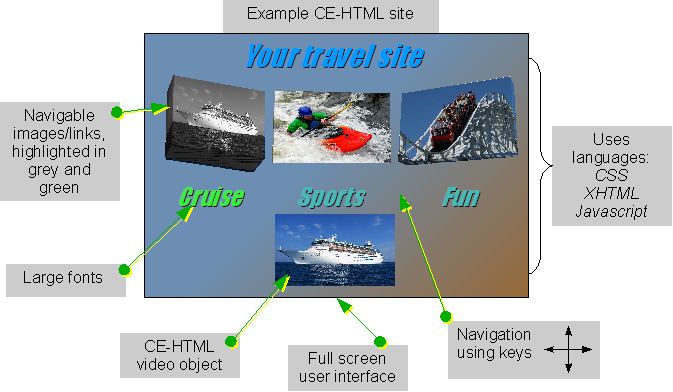 | ||
CE-HTML is an XHTML-based standard for designing webpages with remote user interfaces for consumer electronic devices on Universal Plug and Play networks. The standard is intended for defining user interfaces that can gracefully scale on a variety of screen sizes and geometries, including those of mobile devices to high definition television sets.
Contents
CE-HTML is part of the CEA-2014 standard (also referred to as "Web4CE" which is short for Web for Consumer Electronics), defined within the Consumer Electronics Association (CEA).
Features
CE-HTML consists of the following internet languages:
CE-HTML can both be used in-home through UPnP as via the Internet. It allows the content creator to use the common and known languages in the web to define a user interface that can be controlled on a CE device. A CE-HTML client typically consists of a web browser adapted for the CE-HTML standard running on a consumer electronics device. CE-HTML offers specific extensions for these browsers such as :
Typical CE-HTML code looks like this:
History
CE-HTML was developed within the Consumer Electronics Association R7WG9 working group – consisting of a number of CE-manufacturers – to formulate an answer to the problem of displaying HTML (web) content on a device that does not possess the characteristics of a typical personal computer. CE devices have problems displaying regular web pages because these pages make use of:
Further difficulties with using a CE device to display web content are caused by the fact that CE devices typically have different capabilities such as different resolutions, remote controls and audio/video codecs.
Use
CE-HTML is increasingly used within other standards, such as the Open IPTV Forum, the Digital Living Network Alliance (as of version 2) and HbbTV. Some research suggests that CEA-2014 (of which CE-HTML is an important part) will be one of the key technologies in the living room internet experience. There are currently a number of browser vendors and solution providers that claim to have a CE-HTML capable browser, such as Oregan developed by Oregan Networks Ltd and the Wedison project which is based on Webkit.
Philips released the first devices which support the CE-HTML standard through the Net TV feature in Europe in April, 2009, which in 2010 expanded to include Sharp and Loewe platforms.
Smart TV (sometimes referred to as Connected TV or Hybrid TV) devices are also being released by Samsung, Panasonic and Sony, although these base their work on many other programming languages.
